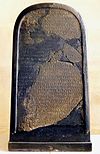Portal:Oriental languages and literature
The Afroasiatic[1] languages constitute one of the world's largest language families with about 375 living languages and more than 350 million speakers spread throughout North Africa, the Horn of Africa, and Southwest Asia, as well as parts of the Sahel, and East Africa. The most widely spoken Afroasiatic language is Arabic, with 230 million speakers (all the colloquial varieties). In addition to languages now spoken, Afroasiatic includes several ancient languages, such as Ancient Egyptian, Biblical Hebrew, and Akkadian.

Egyptian
[edit]
- See also: Ancient Egyptian Wikisource
Egyptian is the indigenous language of Egypt and a branch of the Afroasiatic language family. Written records of the Egyptian language have been dated from about 3400 BC, making it one of the oldest known recorded languages.
- An Account of the Battle of Megiddo
- Ancient Egyptian Love Poems
- Charm for the Protection of a Child
- Great Hymn to Aten, 14th century BCE by Akhenaten, translated by Ernest Alfred Wallis Budge
- Hymn to Osiris-Sokar
- Hymn to the Nile
- Papyrus of Ani
- Text from the Rosetta Stone
- The Dialogue of a Misanthrope with His Own Soul
- The Laments of Isis and Nephthys
- The Magic Book
- The Precepts of Ptah-Hotep
- The Victory of Ramses II Over the Khita
Coptic
[edit]- See also: Coptic Wikisource
Coptic is the final stage of the Egyptian language, a northern Afro-Asiatic language spoken in Egypt until at least the 17th century. Egyptian began to be written using the Greek alphabet in the 1st century. The new writing system became the Coptic script, an adapted Greek alphabet with the addition of six to seven signs from the demotic script to represent Egyptian sounds the Greek language did not have.
- Coptic Literature as it appeared in the 1913 Catholic Encyclopedia
- Coptic Versions of the Bible as it appeared in the 1913 Catholic Encyclopedia
Akkadian
[edit]
- See also: Akkadian category on central Wikisource
Akkadian (also Accadian, Assyro-Babylonian) is an extinct Semitic language that was spoken in ancient Mesopotamia. The earliest attested Semitic language, it used the cuneiform writing system derived ultimately from ancient Sumerian, an unrelated language isolate.
- Enûma Eliš, 12th-18th century BCE (Akkadian)
- The Code of Hammurabi / Codex Hammurabi, c. 1700s BCE by Hammurabi:
- Harper translation, translated in 1904 by Robert Francis Harper
- King translation, translated in 1910 by Leonard William King
- Codex Hammurabi, transliteration column from Hammurabi's Gesetz by J. von Kohler and A. Ungnad (Akkadian)
- Cyrus cylinder, 539-530 BCE, translated by Robert William Rogers
Moabite
[edit]
The Moabite language is an extinct Canaanite language, spoken in Moab (modern day central-western Jordan) in the early first millennium BC. It was written using a variant of the Phoenician alphabet. Most of our knowledge about Moabite comes from the Mesha Stele, which is the only known extensive text in this language.
Hebrew
[edit]
- See also: Hebrew Wikisource
Hebrew is a Semitic language of the Afro-Asiatic language family. Culturally, it is considered the language of the Jewish people, though other Jewish languages had originated among diaspora Jews, and the Jews were only part of the whole Hebrew/Canaanian sprachraum.
Yiddish
[edit]Yiddish is a High German language of Ashkenazi Jewish origin, spoken throughout the world. It developed as a fusion of German dialects with Hebrew, Aramaic, Slavic languages and traces of Romance languages. It is written in the Hebrew alphabet.
- The Aims of Yiddish Philology, 1913 by Ber Borochov
- Hebraismus Militans, 1913 by Ber Borochov
Aramaic
[edit]- See also: Aramaic category on central Wikisource
Aramaic is a Semitic language belonging to the Afroasiatic language family (etym. language of Aram,[3] an ancient region in central Syria). Aramaic script was widely adopted for other languages and is ancestral to both the Arabic and modern Hebrew alphabets.
- Apocrypha-Aramaic Language as it appeared in the 1903 Encyclopaedia Biblica
Syriac
[edit]
Syriac is a dialect of Middle Aramaic that was once spoken across much of the Fertile Crescent. Having first appeared around the 1st century C.E., Classical Syriac became a major literary language throughout the Middle East from the 4th to the 8th centuries, the classical language of Edessa, preserved in a large body of Syriac literature.
Language
[edit]- Syriac as it appeared in the 1897 Easton's Bible Dictionary
- Compendious Syriac Grammar, 1904 by Theodor Nöldeke trans. James Alexander Crichton
Literature
[edit]See also
[edit]Notes
[edit]- ↑ The term "Oriental languages" in the Library of Congress Classification system, while "Afroasiatic languages" is of more modern usage, including use on Wikipedia
